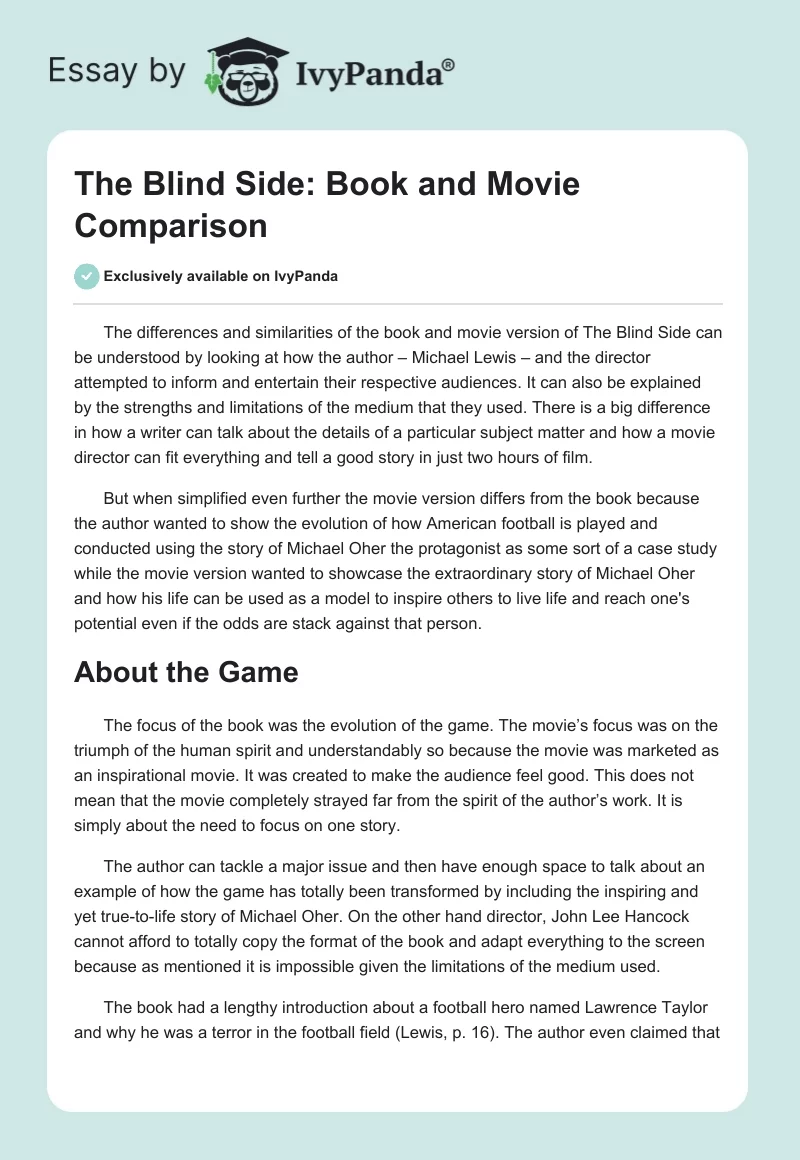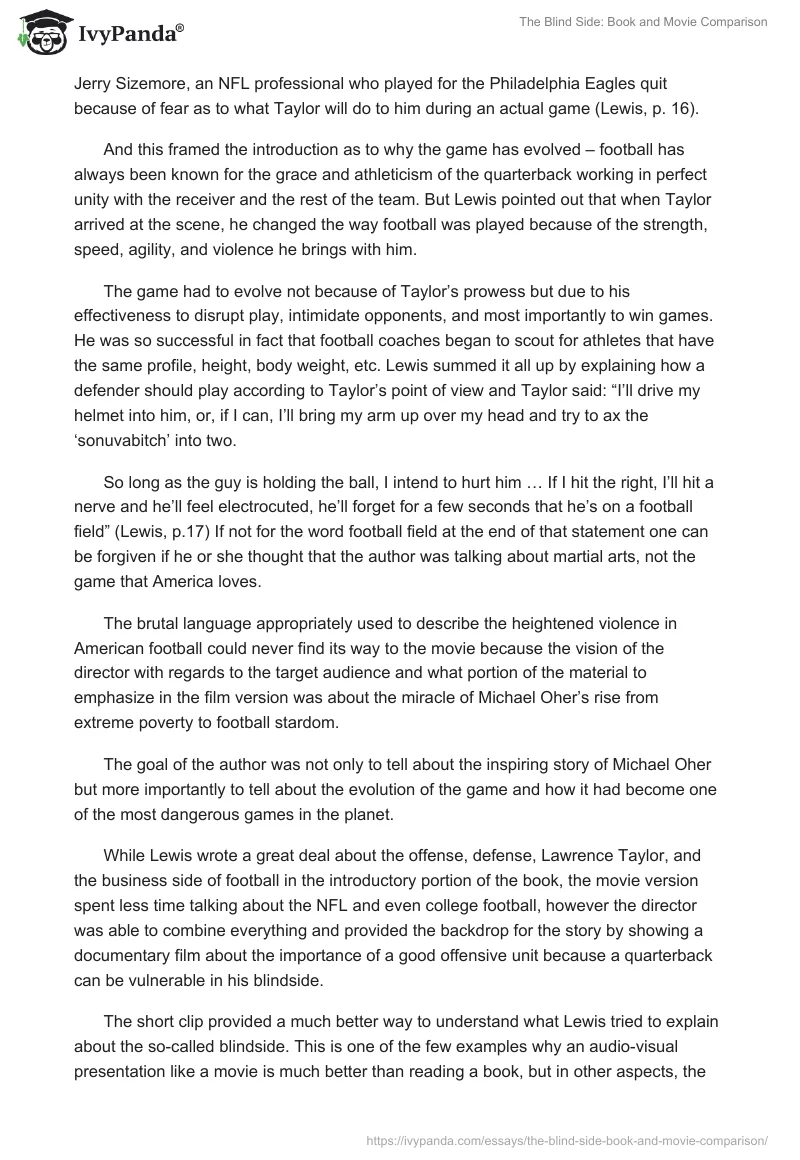The differences and similarities of the book and movie version of The Blind Side can be understood by looking at how the author – Michael Lewis – and the director attempted to inform and entertain their respective audiences. It can also be explained by the strengths and limitations of the medium that they used. There is a big difference in how a writer can talk about the details of a particular subject matter and how a movie director can fit everything and tell a good story in just two hours of film.
But when simplified even further the movie version differs from the book because the author wanted to show the evolution of how American football is played and conducted using the story of Michael Oher the protagonist as some sort of a case study while the movie version wanted to showcase the extraordinary story of Michael Oher and how his life can be used as a model to inspire others to live life and reach one’s potential even if the odds are stack against that person.
About the Game
The focus of the book was the evolution of the game. The movie’s focus was on the triumph of the human spirit and understandably so because the movie was marketed as an inspirational movie. It was created to make the audience feel good. This does not mean that the movie completely strayed far from the spirit of the author’s work. It is simply about the need to focus on one story.
The author can tackle a major issue and then have enough space to talk about an example of how the game has totally been transformed by including the inspiring and yet true-to-life story of Michael Oher. On the other hand director, John Lee Hancock cannot afford to totally copy the format of the book and adapt everything to the screen because as mentioned it is impossible given the limitations of the medium used.
The book had a lengthy introduction about a football hero named Lawrence Taylor and why he was a terror in the football field (Lewis, p. 16). The author even claimed that Jerry Sizemore, an NFL professional who played for the Philadelphia Eagles quit because of fear as to what Taylor will do to him during an actual game (Lewis, p. 16).
And this framed the introduction as to why the game has evolved – football has always been known for the grace and athleticism of the quarterback working in perfect unity with the receiver and the rest of the team. But Lewis pointed out that when Taylor arrived at the scene, he changed the way football was played because of the strength, speed, agility, and violence he brings with him.
The game had to evolve not because of Taylor’s prowess but due to his effectiveness to disrupt play, intimidate opponents, and most importantly to win games. He was so successful in fact that football coaches began to scout for athletes that have the same profile, height, body weight, etc. Lewis summed it all up by explaining how a defender should play according to Taylor’s point of view and Taylor said: “I’ll drive my helmet into him, or, if I can, I’ll bring my arm up over my head and try to ax the ‘sonuvabitch’ into two.
So long as the guy is holding the ball, I intend to hurt him … If I hit the right, I’ll hit a nerve and he’ll feel electrocuted, he’ll forget for a few seconds that he’s on a football field” (Lewis, p.17) If not for the word football field at the end of that statement one can be forgiven if he or she thought that the author was talking about martial arts, not the game that America loves.
The brutal language appropriately used to describe the heightened violence in American football could never find its way to the movie because the vision of the director with regards to the target audience and what portion of the material to emphasize in the film version was about the miracle of Michael Oher’s rise from extreme poverty to football stardom.
The goal of the author was not only to tell about the inspiring story of Michael Oher but more importantly to tell about the evolution of the game and how it had become one of the most dangerous games in the planet.
While Lewis wrote a great deal about the offense, defense, Lawrence Taylor, and the business side of football in the introductory portion of the book, the movie version spent less time talking about the NFL and even college football, however the director was able to combine everything and provided the backdrop for the story by showing a documentary film about the importance of a good offensive unit because a quarterback can be vulnerable in his blindside.
The short clip provided a much better way to understand what Lewis tried to explain about the so-called blindside. This is one of the few examples why an audio-visual presentation like a movie is much better than reading a book, but in other aspects, the author was able to talk more about the details of football and why Michael Oher was an extraordinary story in the world of American football.
About Michael Oher
Lewis saw the life of Michael Oher as an example of the best and worst of college football, U.S. athletics, and football as a game and as a business. So the book was not all about Michael Oher but also about football. The author wrote several chapters about the marketing of football players, coaches, and how the game is currently being played.
He wanted to use the story of Oher to show that a football scholarship is something that can be seen as a blessing and sometimes a tool used by schemers who do not really care about the welfare and the future of the athletes they recruited, for they simply wanted the glory that is associated with it.
In the book, Lewis highlighted the fact that Briarcrest Christian School looked the other way when they knew without a doubt that Michael Oher could not maintain the high academic standards that the school requires.
They decided to ignore this very important aspect of his enrollment because an athletics coach of Briarcrest saw the potential of Oher to dominate the competition (Lewis, p.331). This, of course, an unethical thing to do, a dilemma that the school had to deal with and provided another backdrop to what would happen next to Oher’s life as a football player.
But in the movie version, the ethical problem regarding recruitment was not highlighted, in fact, it can be said that the producer of the movie did not want to get deep into the controversy. What the producer and the director focused on was the struggle that Oher had to face with and deal with as an oversize black student studying in a highly competitive and predominantly white school.
The book also trained the spotlight on how coaches and the staff of some of the most popular college football teams had to employ what can be considered as tactics reserved for the professional leagues. They behaved like pirates in the high seas and treated the recruitment process as if they are on war.
This was also evident in the movie version but it was toned down. The impression of the audience of the selection process was intense but at the same time exhilarating. The movie did not touch on the more controversial aspects of the recruitment process. This is why it is called a feel-good movie.
Similarities
It has now become clear that the movie version was unable to stay one hundred percent true to the original intent of the writer. Nevertheless, there were many similarities and many times the storyline of the movie and the information that one can come across by reading the book has intersected and most of it has something to do with the extraordinary character of Michael Oher and of course the members of the Tuohy family.
The way these people’s lives were celebrated was obvious in the book and in the movie version. The way the movie portrayed the life of Michael Oher and the way the author wrote about him has the same effect on the reader of the book as well as the audience of the film.
The most important feature of the film and the book was in describing how multiple foster homes and the experience of not having to have stability in life has shaped the worldview of Oher. The book also highlighted the fact that Oher’s talent and even determination would never be enough without the Tuohy family.
As extraordinary as Oher is, his early failures and troubled past could have brought him to the depths of despair where his physical prowess cannot help him. The book and the movie were able to show very clearly that the poverty and gangs related violence found in inner-city Memphis was like a deathtrap that no orphan can ever conquer.
Conclusion
It must be expected that the movie version can only focus on a small part of the book. The producer and director of the movie had to contend with the limitations of film. The author intended to talk about the evolution of the game, both the good and the bad effects, but the movie was content to talk about the triumph of Oher and the Tuohy family. Nevertheless, there were similarities such as the moving story of how Oher was able to overcome against great odds.
Works Cited
Lewis, Michael. The Blind Side (Movie Tie-In Edition). New York: W.W. Norton & Company, 2009.
The Blind Side. Dir. John Lee Hancock. Perf. Sandra Bullock, Tim McGraw, Quinton Aaron and Kathy Bates. Warner Brothers Pictures, 2009. Film.


